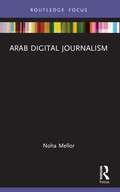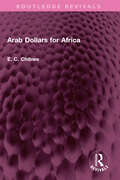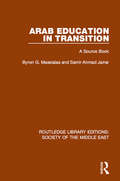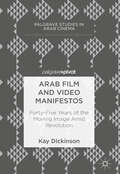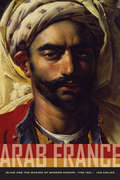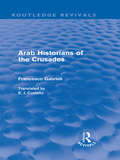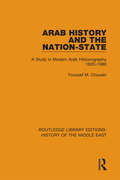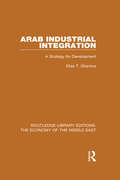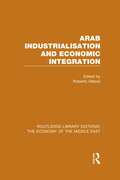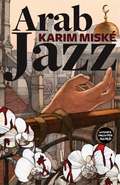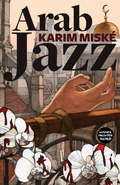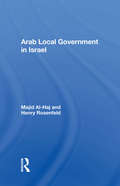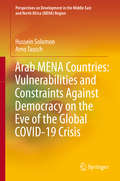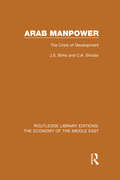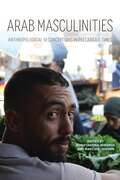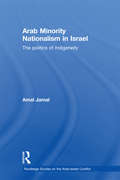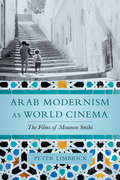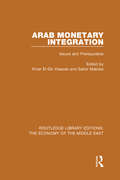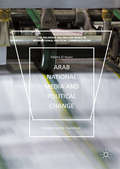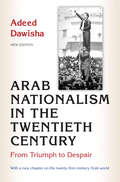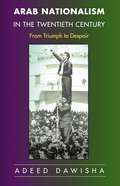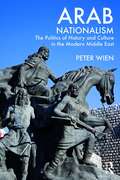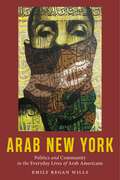- Table View
- List View
Arab Development Challenges of the New Millennium
by Belkacem LaabasThis title was first published in 2002. In 2000, a major international conference was organized by the Arab Planning Institute to identify, analyze and compare development challenges facing Arab countries at the dawn of the new millennium. An interdisciplinary team of scholars were brought together from the fields of regional science, development studies, economics, business and government policy and together they addressed global, regional and domestic challenges and their impact on the Arab region. This volume brings together the best papers presented at this conference. In doing so, it offers up-to-date insights into, and a clearer understanding of this region. It highlights issues including: economic and social implications of globalization; strategic alliances; the implications for Arab countries of emerging technological patterns; the impact of the European Monetary Union and the euro; Arab regional integration; education; and the development of individual Arab country's economies.
Arab Digital Journalism (Disruptions)
by Noha MellorResponding to urgent calls to de-westernise Media and Journalism Studies and shed light on local agency, this book examines digital journalistic practices in the Arab region, exploring how Arab journalists understand their roles and how digital technologies in Arab newsrooms are used to influence public opinion. Drawing on tens of articles penned by Arab media professionals and scholars, supplemented with informal conversations with journalists, this book reviews the historical development of digital journalism in the region and individual journalists’ perceptions of this development. While technology has provided a new platform for citizens and powerful agents to exchange views, this text examines how it has simultaneously allowed Arab states and authorities to conduct surveillance on journalists, curtail the rise of citizen journalism, and maintain offline hierarchal forms of political, economic, and cultural powers. Mellor also explores how digital technology serves to cement Western hegemony of the information world order, with Arab media organisations and audiences judged to be mere recipients, rather than producers, of such information. Arab Digital Journalism offers an important contribution to the emerging field of digital journalism in the Global South and is a valuable resource for students and researchers interested in media, journalism, communication, and development studies.
Arab Dollars for Africa (Routledge Revivals)
by E. C. ChibweFirst Published in 1976, Arab Dollars for Africa examines how Arab funds can be recycled into the African Economy. The long-term industrial future of the Arab oil producers is dependent on the availability of raw materials. Africa as a whole contains vast reserves of vital minerals, but they require considerable investment for their exploitation. The Arab states are well placed to participate in the development of the African economy both on the basis of state-to-state cooperation and through individual enterprises. Africa and the Arab world share economic goals as members of the developing world and as key primary producers and have a common purpose in bringing about a new international economic order. This book deals in detail with investment opportunities in national development banks and in individual agricultural and industrial projects. This is an important historical analysis for scholars and researchers of African studies, international politics and geopolitics.
Arab Education in Transition: A Source Book (Routledge Library Editions: Society of the Middle East #2)
by Byron G. Massialas Samir Ahmad JarrarThe operation of schools in the Arab world is a topic about which very little is known in the West. This volume, first published in 1991, provides information about the Arab school and thus contributes to an understanding of what is taught, by whom, and under what conditions. It seeks to define the interaction between traditional elements and innovative forces impinging on the Arab school, as well as reviewing policies that concern the education of Arab children. It is maintained that Arab schools are in a state of transition, reproducing society and its norms on one hand while on the other operating as agents seeking to transform society. This work examines this claim in detail, providing a unique discussion about education in the Arab world.
Arab Film and Video Manifestos: Forty-Five Years of the Moving Image Amid Revolution (Palgrave Studies in Arab Cinema)
by Kay DickinsonArab Film and Video Manifestos presents, in their entirety, five key documents that have fundamentally shaken up and helped change the face of image culture in the Middle East and beyond. The book collects together, for the first time, these influential, collectively written calls and directives that span a fifty-year period and hail from a range of different countries. Each urges a radical rethinking of film and video’s role in culture, its relation to politics, and its potential to instigate profound change. Kay Dickinson carefully positions the manifestos within their broader socio-historical contexts and provides supplementary reading and viewing suggestions for readers who cannot access Arabic-language sources.
Arab France
by Ian CollerMany think of Muslims in Europe as a twentieth century phenomenon, but this book brings to life a lost community of Arabs who lived through war, revolution, and empire in early nineteenth century France. Ian Coller uncovers the surprising story of the several hundred men, women, and children--Egyptians, Syrians, Greeks, and others--who followed the French army back home after Napoleon's occupation of Egypt. Based on research in neglected archives, on the rediscovery of forgotten Franco-Arab authors, and on a diverse collection of visual materials, the book builds a rich picture of the first Arab France--its birth, rise, and sudden decline in the age of colonial expansion. As he excavates a community that was nearly erased from the historical record, Coller offers a new account of France itself in this pivotal period, one that transcends the binary framework through which we too often view history by revealing the deep roots of exchange between Europe and the Muslim world, and showing how Arab France was in fact integral to the dawn of modernity.
Arab Historians of the Crusades (Routledge Revivals)
by Francesco GabrieliThe recapture of Jerusalem, the siege of acre, the fall of Tripoli, the effect in Baghdad of events in Syria; these and other happenings were faithfully recorded by Arab historians during the two centuries of the Crusades. First published in English in 1969, this book presents 'the other side' of the Holy War, offering the first English translation of contemporary Arab accounts of the fighting between Muslim and Christian. Extracts are drawn from seventeen different authors encompassing a multitude of sources: The general histories of the Muslim world, The chronicles of cities, regions and their dynasties Contemporary biographies and records of famous deeds. Overall, this book gives a sweeping and stimulating view of the Crusades seen through Arab eyes.
Arab History and the Nation-State: A Study in Modern Arab Historiography 1820-1980 (Routledge Library Editions: History of the Middle East #1)
by Youssef M. ChoueiriThe study of Arab historiography and of the emergence of the Arab nation-state as an object of historical treatment is a matter of considerable current interest. Despite its importance, no academic work has dealt with this subject as a major preoccupation of Arab historians and intellectuals. This book, first published in 1989, discusses the development of modern Arab historiography and its study of the nation-state in the nineteenth century, and analyses the work of three contemporary Arab historians from Egypt, the Lebanon and Morocco. An important and highly readable account, it reaffirms the importance of historiography and proposes a revision of the manner in which modern Arab thought has hitherto been classified and interpreted.
Arab Industrial Integration: A Strategy for Development (Routledge Library Editions: The Economy Of The Middle East Ser.)
by Elias T. GhantusThe Arab countries are increasingly recognising their importance as a regional economic grouping. Given the highly skewed distribution of natural, human and financial resources, the course of economic development in the Arab countries seems to be interrelated. Through pooling their resources and markets these countries will not only be able to optimise investment decisions but also broaden the potential for development. This book argues that economic integration is not merely a question of reducing or eliminating discriminatory measures, as emphasised in previous integration attempts. It calls rather for a positive action based on a regional investment strategy which coordinates production programmes, to reap the benefits of specialisation and scale. The book focuses on past industrialisation efforts in the Arab countries and examines the emerging patterns of industrial growth. A pioneering attempt is made to identify specific industries whose economic viability can be enhanced by conceiving them on a regional basis. The book concludes by framing a strategy for an integrated industrial development in the Arab region.First published in 1982.
Arab Industrialisation and Economic Integration (Routledge Library Editions: The Economy of the Middle East)
by Roberto AliboniIndependently commissioned by IAI, the three studies comprising this book examine inter-Arab industrial and economic cooperation. The first chapter analyses the industrial strategies, economic policies and attempts at harmonisation and cooperation of the Arab countries, providing a detailed picture of the convergences and divergences, the potential and the difficulties faced by the region. The second chapter examines the importance of coordinating economic polices if economic integration is to be sustained, and considers the implications to the world economy. Lastly, the third chapter examines Arab labour flows, a key factor in the development of the Arab countries. First published in 1979.
Arab Jazz
by Karim Miské Sam GordonKosher sushi, kebab stands, a secondhand bookstore, and a bar: the 19th arrondissement in Paris has all the trappings of a cosmopolitan melting pot--a place where multiethnic citizens live, love, and worship alongside one another. But dark passions are brewing beneath the seemingly idyllic vision of peacefully coexisting ethnicities. Ahmed Taroudant is an archetypal French Arab-non-observant, unable to reconcile his conflicting identities, and troubled by the past. A crime fiction connoisseur, Ahmed is engrossed in his latest book when he finds blood dripping from his upstairs neighbor's apartment. There, Laura Vignole is found brutally murdered, with a joint of pork placed near her body, prompting the obvious conclusion that the killer had religious motives. As the neighborhood erupts into speculation and gossip, Ahmed finds himself first among many suspects. Detectives Rachel Kupferstein and Jean Hamelot attempt to untangle the complex web of events leading up to Laura's death, but truth is hard to come by, with each inhabitant--an Armenian anarchist, a Turkish kebab-shop owner, and a Hasidic Rastafarian--reluctant to reveal anything. Determined to clear his name, Ahmed joins the detectives as they investigate the connection between a disbanded hip-hop group and the fiery extremist preachers clamoring for attention in the streets. Meanwhile, an ecstasy variant called Godzwill is taking the district by storm. In his debut novel, Karim Miské demonstrates a masterful control of setting, as he moves effortlessly between the sensual streets of Paris and the synagogues of New York to reveal the truth behind a horrifying crime.
Arab Jazz
by Karim MiskéKosher sushi, kebabs, a second hand bookshop and a bar: the 19th arrondissement in Paris is a cosmopolitan neighbourhood where multicultural citizens live, love and worship alongside one another. This peace is shattered when Ahmed Taroudant's melancholy daydreams are interrupted by the blood dripping from his upstairs neighbour's brutally mutilated corpse. The violent murder of Laura Vignole, and the pork joint placed next to her, set imaginations ablaze across the neighborhood, and Ahmed finds himself the prime suspect. However detectives Rachel Kupferstein and Jean Hamelot are not short of leads. What is the connection between a disbanded hip-hop group and the fiery extremist preachers that jostle in the streets for attention? And what is the mysterious new pill that is taking the district by storm? In this his debut novel, Karim Miské demonstrates a masterful control of setting, as he moves seamlessly between the sensual streets of Paris and the synagogues of New York to reveal the truth behind a horrifying crime.
Arab Local Government In Israel
by Majid Al-hajA study in the project The Status and Condition of the Arabs in Israel under the direction of Professor Henry Rosenfeld. In this book the authors present a historical analysis of local authorities in Arab communities prior to and since the establishment of the state of Israel. They discuss the workings of Arab local councils, municipalities, and national political groupings as well as the circumstances of internal conflicts in Arab settlements. They also present comparative data on budgets in Jewish and Arab communities.
Arab MENA Countries: Vulnerabilities and Constraints Against Democracy on the Eve of the Global COVID-19 Crisis (Perspectives on Development in the Middle East and North Africa (MENA) Region)
by Hussein Solomon Arno TauschThis book offers readers critical insights into a region in crisis and explores different facets of the crisis from governance to gender to the politics of identity, the challenge of the environment and the enduring impact of demographic variables and technological change. Whilst exploring the nature of the crises, the book also explores how policy-makers have responded to these and what other alternatives there are in overcoming challenges posed. Whilst the focus is on the Middle East North Africa region as a whole, the authors are well aware of the unique characteristics of individual countries. Hence the book examines regional trends whilst also being conscious of the national specificities of each country. In combining the general with the particular, the book approaches its subject matter from both a quantitative and a qualitative perspective allowing one to understand regional trends and country specific peculiarities.
Arab Manpower: The Crisis of Development (Routledge Library Editions: The Economy Of The Middle East Ser.)
by J.S. Birks C.A. SinclairThe Arab world increasingly falls into two divisions, the capital-poor and the capital-rich countries (where capital means, in essence, oil). In the capital-rich countries shortage of labour is the chief constraint on growth. In the capital-poor countries analysis of the labour market is equally central, as shortage of labour compounds the already existing problem of shortage of capital. This book surveys the labour markets of the Arab world state by state, evaluating them by demand and supply analysis, and analysing the different elements in trends of employment. It forecasts the areas of stress in the next decade and suggests ways of minimising them. The book, based on much previously unpublished information and on extensive on-the-spot research in the respective Arab countries, sets out the economic and social conditions which underly the impending crisis of development in the Arab region.First published in 1980.
Arab Masculinities: Anthropological Reconceptions in Precarious Times (Public Cultures of the Middle East and North Africa)
by Laura Ferrero Alice Elliot Jamie Furniss Bård Helge Kårtveit Hsain Ilahiane Anne Hovgaard Jørgensen Gustavo Barbosa Sabiha Allouche Lisa L. WynnArab Masculinities provides a groundbreaking analysis of Arab men's lives in the precarious aftermath of the 2011 Arab uprisings. It challenges received wisdoms and entrenched stereotypes about Arab men, offering new understandings of rujula, or masculinity, across the Middle East and North Africa.The 10 individual chapters of the book foreground the voices and stories of Arab men as they face economic precarity, forced displacement, and new challenges to marriage and family life. Rich in ethnographic details, they illuminate how men develop alternative strategies of affective labor, how they attempt to care for themselves and their families within their local moral worlds, and what it means to be a good son, husband, father, and community member. Arab Masculinities sheds light on the most private spaces of Arab men's lives—offering stories that rarely enter the public realm. It is a pioneering volume that reflects the urgent need for new anthropological scholarship on men and masculinities in a changing Middle East.
Arab Minority Nationalism in Israel: The Politics of Indigeneity (Routledge Studies in Middle Eastern Politics)
by Amal JamalNational minorities and their behaviour have become a central topic in comparative politics in the last few decades. Using the relationship between the state of Israel and the Arab national minority as a case study, this book provides a thorough examination of minority nationalism and state-minority relations in Israel. Placing the case of the Arab national minority in Israel within a comparative framework, the author analyses major debates taking place in the field of collective action, social movements, civil society and indigenous rights. He demonstrates the impact of the state regime on the political behaviours of the minorities, and sheds light on the similarities and differences between various types of minority nationalisms and the nature of the relationship such minorities could have with their states. Drawing empirical and theoretical conclusions that contribute to studies of Israeli politics, political minorities, indigenous populations and conflict issues, this book will be a valuable reference for students and those in policy working on issues around Israeli politics, Palestinian politics and the broader Palestinian-Israeli conflict.
Arab Modernism as World Cinema: The Films of Moumen Smihi
by Peter LimbrickArab Modernism as World Cinema explores the radically beautiful films of Moroccan filmmaker Moumen Smihi, demonstrating the importance of Moroccan and Arab film cultures in histories of world cinema. Addressing the legacy of the Nahda or "Arab Renaissance" of the nineteenth and early twentieth century—when Arab writers and artists reenergized Arab culture by engaging with other languages and societies—Peter Limbrick argues that Smihi’s films take up the spirit of the Nahda for a new age. Examining Smihi’s oeuvre, which enacts an exchange of images and ideas between Arab and non-Arab cultures, Limbrick rethinks the relation of Arab cinema to modernism and further engages debates about the use of modernist forms by filmmakers in the Global South. This original study offers new routes for thinking about world cinema and modernism in the Middle East and North Africa, and about Arab cinema in the world.
Arab Monetary Integration: Issues and Prerequisites (Routledge Library Editions: The Economy of the Middle East)
by Samir Makdisi Khair El-Din HaseebPre-eminent among the requisites for economic integration is monetary integration. It is the premise of the chapters in this book that if the Arab world is to achieve a closer degree of cooperation in economic and political spheres, the issue of monetary integration must be given much more attention. To this end the contributors to this book, who include well-known academics and economic experts from the Arab countries, Europe, the USA and Latin America, have looked at the experience of other areas of the world which have introduced monetary unity. They consider the experiences of Western Europe, Latin America and Western Africa, evaluating them with the objective of focusing on the various major issues which have to be coped with when planning for closer monetary cooperation. While the analysis concerning the scope for future Arab monetary integration revealed varying positions as to the factors which should be stressed and the pre-requisites which should be fulfilled, there emerged general agreement on certain major issues including the following: at the present time the Arab countries should strive to achieve partial rather than full monetary integration and to create the requisite conditions for such a move; economic and monetary integration should be viewed as mutually reinforcing rather than as successive processes; and the political will to achieve integration is a major pre-requisite for any move in that direction. First published in 1981.
Arab National Media and Political Change: “Recording the Transition” (The Palgrave Macmillan Series in International Political Communication)
by Fatima El-IssawiThis book examines the evolution of national Arab media and its interplay with political change, particularly in emerging democracies in the context of the Arab uprisings. Investigated from a journalistic perspective, this research addresses the role played by traditional national media in consolidating emerging democracies or in exacerbating their fragility within new political contexts. Also analyzed are the ways journalists report about politics and transformations of these media industries, drawing on the international experiences of media in transitional societies. This study builds on a field investigation led by the author and conducted within the project “Arab Revolutions: Media Revolutions,” covering Libya, Tunisia, and Egypt.
Arab Nationalism in the Twentieth Century
by Adeed DawishaLike a great dynasty that falls to ruin and is eventually remembered more for its faults than its feats, Arab nationalism is remembered mostly for its humiliating rout in the 1967 Six Day War, for inter-Arab divisions, and for words and actions distinguished by their meagerness. But people tend to forget the majesty that Arab nationalism once was. In this elegantly narrated and richly documented book, Adeed Dawisha brings this majesty to life through a sweeping historical account of its dramatic rise and fall. Dawisha argues that Arab nationalism--which, he says, was inspired by nineteenth-century German Romantic nationalism--really took root after World War I and not in the nineteenth century, as many believe, and that it blossomed only in the 1950s and 1960s under the charismatic leadership of Egypt's Gamal 'Abd al-Nasir. He traces the ideology's passage from the collapse of the Ottoman Empire through its triumphant ascendancy in the late 1950s with the unity of Egypt and Syria and with the nationalist revolution of Iraq, to the mortal blow it received in the 1967 Arab defeat by Israel, and its eventual eclipse. Dawisha criticizes the common failure to distinguish between the broader, cultural phenomenon of "Arabism" and the political, secular desire for a united Arab state that defined Arab nationalism. In recent decades competitive ideologies--not least, Islamic militancy--have inexorably supplanted the latter, he contends. Dawisha, who grew up in Iraq during the heyday of Arab nationalism, infuses his work with rare personal insight and extraordinary historical breadth. In addition to Western sources, he draws on an unprecedented wealth of Arab political memoirs and studies to tell the fascinating story of one of the most colorful and significant periods of the contemporary Arab world. In doing so, he also gives us the means to more fully understand trends in the region today. Complete with a hard-hitting new and expanded section that surveys recent nationalism and events in the Middle East, Arab Nationalism in the Twentieth Century tells the fascinating story of one of the most colorful and significant periods in twentieth-century Middle Eastern history.
Arab Nationalism in the Twentieth Century: From Triumph to Despair
by Adeed DawishaLike a great dynasty that falls to ruin and is eventually remembered more for its faults than its feats, Arab nationalism is remembered mostly for its humiliating rout in the 1967 Six Day War, for inter-Arab divisions, and for words and actions distinguished by their meagerness. But people tend to forget the majesty that Arab nationalism once was. In this elegantly narrated and richly documented book, Adeed Dawisha brings this majesty to life through a sweeping historical account of its dramatic rise and fall. Dawisha argues that Arab nationalism--which, he says, was inspired by nineteenth-century German Romantic nationalism--really took root after World War I and not in the nineteenth century, as many believe, and that it blossomed only in the 1950s and 1960s under the charismatic leadership of Egypt's Gamal 'Abd al-Nasir. He traces the ideology's passage from the collapse of the Ottoman Empire through its triumphant ascendancy in the late 1950s with the unity of Egypt and Syria and with the nationalist revolution of Iraq, to the mortal blow it received in the 1967 Arab defeat by Israel, and its eventual eclipse. Dawisha criticizes the common failure to distinguish between the broader, cultural phenomenon of "Arabism" and the political, secular desire for a united Arab state that defined Arab nationalism. In recent decades competitive ideologies--not least, Islamic militancy--have inexorably supplanted the latter, he contends. Dawisha, who grew up in Iraq during the heyday of Arab nationalism, infuses his work with rare personal insight and extraordinary historical breadth. In addition to Western sources, he draws on an unprecedented wealth of Arab political memoirs and studies to tell the fascinating story of one of the most colorful and significant periods of the contemporary Arab world. In doing so, he also gives us the means to more fully understand trends in the region today.
Arab Nationalism in the Twentieth Century: From Triumph to Despair
by Adeed DawishaLike a great dynasty that falls to ruin and is eventually remembered more for its faults than its feats, Arab nationalism is remembered mostly for its humiliating rout in the 1967 Six Day War, for inter-Arab divisions, and for words and actions distinguished by their meagerness. But people tend to forget the majesty that Arab nationalism once was. In this elegantly narrated and richly documented book, Adeed Dawisha brings this majesty to life through a sweeping historical account of its dramatic rise and fall.Dawisha argues that Arab nationalism--which, he says, was inspired by nineteenth-century German Romantic nationalism--really took root after World War I and not in the nineteenth century, as many believe, and that it blossomed only in the 1950s and 1960s under the charismatic leadership of Egypt's Gamal 'Abd al-Nasir. He traces the ideology's passage from the collapse of the Ottoman Empire through its triumphant ascendancy in the late 1950s with the unity of Egypt and Syria and with the nationalist revolution of Iraq, to the mortal blow it received in the 1967 Arab defeat by Israel, and its eventual eclipse. Dawisha criticizes the common failure to distinguish between the broader, cultural phenomenon of "Arabism" and the political, secular desire for a united Arab state that defined Arab nationalism. In recent decades competitive ideologies--not least, Islamic militancy--have inexorably supplanted the latter, he contends.Dawisha, who grew up in Iraq during the heyday of Arab nationalism, infuses his work with rare personal insight and extraordinary historical breadth. In addition to Western sources, he draws on an unprecedented wealth of Arab political memoirs and studies to tell the fascinating story of one of the most colorful and significant periods of the contemporary Arab world. In doing so, he also gives us the means to more fully understand trends in the region today.
Arab Nationalism: The Politics of History and Culture in the Modern Middle East
by Peter WienArab nationalism has been one of the dominant ideologies in the Middle East and North Africa since the early twentieth century. However, a clear definition of Arab nationalism, even as a subject of scholarly inquiry, does not yet exist. Arab Nationalism sheds light on cultural expressions of Arab nationalism and the sometimes contradictory meanings attached to it in the process of identity formation in the modern world. It presents nationalism as an experienceable set of identity markers – in stories, visual culture, narratives of memory, and struggles with ideology, sometimes in culturally sophisticated forms, sometimes in utterly vulgar forms of expression. Drawing upon various case studies, the book transcends a conventional history that reduces nationalism in the Arab lands to a pattern of political rise and decline. It offers a glimpse at ways in which Arabs have constructed an identifiable shared national culture, and it critically dissects conceptions about Arab nationalism as an easily graspable secular and authoritarian ideology modeled on Western ideas and visions of modernity. This book offers an entirely new portrayal of nationalism and a crucial update to the field, and as such, is indispensable reading for students, scholars and policymakers looking to gain a deeper understanding of nationalism in the Arab world.
Arab New York: Politics and Community in the Everyday Lives of Arab Americans
by Emily Regan WillsFrom Bay Ridge to Astoria, explore political action in Arab New York Arab Americans are a numerically small proportion of the US population yet have been the target of a disproportionate amount of political scrutiny. Most non-Arab Americans know little about what life is actually like within Arab communities and in organizations run by and for the Arab community. Big political questions are central to the Arab American experience—how are politics integrated into Arab Americans’ everyday lives? In Arab New York, Emily Regan Wills looks outside the traditional ideas of political engagement to see the importance of politics in Arab American communities in New York. Regan Wills focuses on the spaces of public and communal life in the five boroughs of New York, which are home to the third largest concentration of people of Arab descent in the US. Many different ethnic and religious groups form the overarching Arab American identity, and their political engagement in the US is complex.Regan Wills examines the way that daily practice and speech form the foundation of political action and meaning. Drawing on interviews and participant observation with activist groups and community organizations, Regan Wills explores topics such as Arab American identity for children, relationships with Arab and non-Arab Americans, young women as leaders in the Muslim and Arab American community, support and activism for Palestine, and revolutionary change in Egypt and Yemen. Ultimately, she claims that in order to understand Arab American political engagement and see how political action develops in Arab American contexts, one must understand Arab Americans in their own terms of political and public engagement. They are, Regan Wills argues, profoundly engaged with everyday politics and political questions that don’t match up to conventional politics. Arab New York draws from rich ethnographic data and presents a narrative, compelling picture of a community engaging with politics on its own terms. Written to expand the existing literature on Arab Americans to include more direct engagement with politics and discourse, Arab New York also serves as an appropriate introduction to Arab American communities, ethnic dynamics in New York City and elsewhere in urban America, and the concept of everyday politics.

